Cholesterol Impact Calculator
Estimated Cholesterol Changes
Ever wondered if that nightly glass of wine is helping or hurting your cholesterol? The link between alcohol and cholesterol is more than a myth - it’s a mix of biology, dosage, and personal health factors. Below you’ll find a clear, step‑by‑step look at how drinking shapes hypercholesterolemia and what you can actually do about it.
What Is Hypercholesterolemia?
Hypercholesterolemia is a condition characterized by elevated levels of cholesterol in the blood, primarily low‑density lipoprotein (LDL) cholesterol. When LDL climbs beyond recommended limits, plaque can build up in arteries, raising the risk of heart attacks and strokes. Roughly 1 in 3 adults in Australia carries high cholesterol, and many are unaware until a routine test flags the issue.
Defining Alcohol Consumption
Alcohol consumption refers to the intake of ethanol‑containing beverages such as beer, wine, or spirits. Health agencies split drinking into three categories:
- Abstinent - no alcohol at all.
- Moderate - up to 10 g of pure alcohol per day for women and 20 g for men (roughly one standard drink).
- Heavy or binge - more than 30 g per day for women, 40 g for men, or ≥5 drinks on a single occasion.
These thresholds matter because the body’s response to ethanol changes dramatically with dose.
How Alcohol Touches Lipid Metabolism
When you sip a drink, ethanol is processed mainly in the liver. The liver’s job is to break down ethanol into acetaldehyde and then acetate, which the body can use for energy. This metabolic pathway interferes with how the liver handles fats:
- HDL cholesterol (the "good" cholesterol) often rises modestly with moderate alcohol, improving the HDL/LDL ratio.
- LDL cholesterol may stay the same or drop slightly, but heavy drinking can actually increase LDL particles.
- Triglycerides spike sharply with excess alcohol as the liver churns out more VLDL particles.
- Liver metabolism becomes overloaded, leading to fatty liver disease, which further disrupts cholesterol synthesis.
In short, a little ethanol can boost the protective HDL shield, but too much fuels the harmful LDL and triglyceride surge.
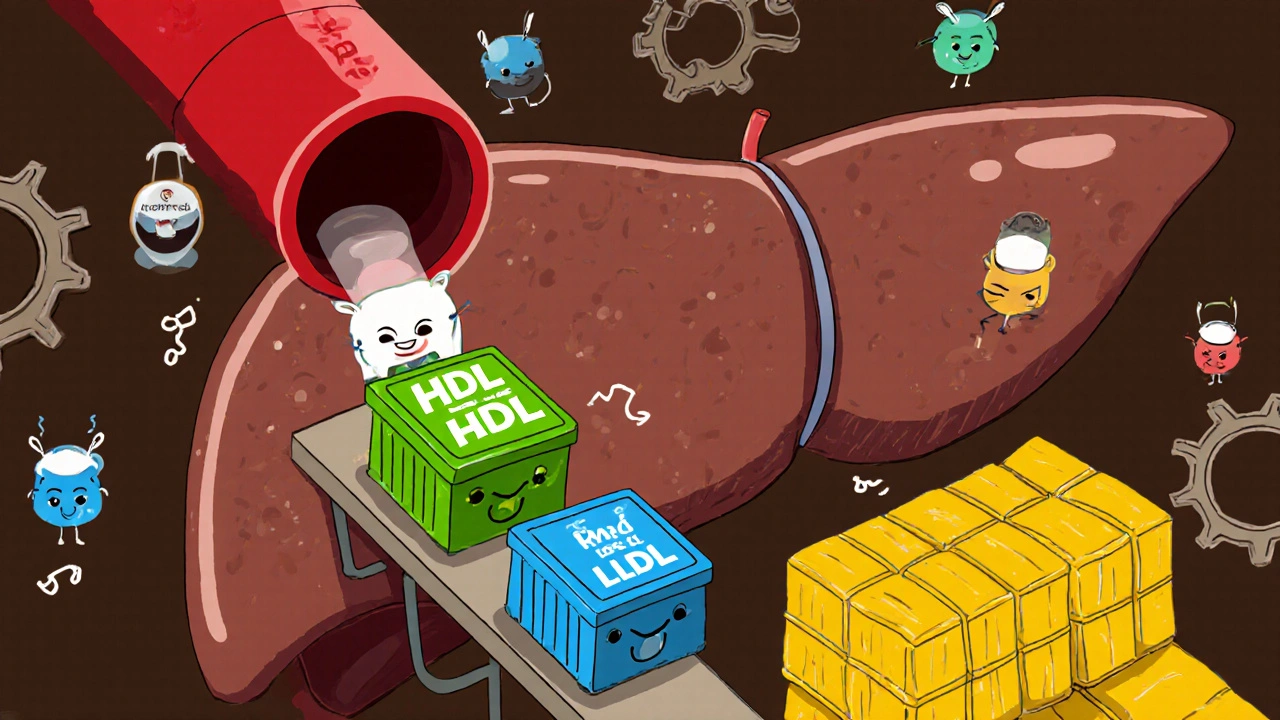
Evidence From Large‑Scale Studies
Several cohort studies have mapped drinking patterns to cholesterol outcomes:
- The 2022 Australian Health Survey (n = 16,200) found that moderate wine drinkers had, on average, 5 mg/dL higher HDL and 3 mg/dL lower LDL than abstainers.
- A 2023 meta‑analysis of 34 prospective studies (over 1.2 million participants) reported a J‑shaped curve: risk of cardiovascular events fell by 12 % at 1 drink/day but rose sharply after 3 drinks/day, driven mainly by triglyceride spikes.
- Research from the WHO Global Burden of Disease (2024) highlighted that binge drinking contributed to 8 % of the global hypercholesterolemia burden, especially in men under 50.
These numbers reinforce the dose‑dependent nature of alcohol’s impact.
Who Is Most Affected?
Not everyone reacts the same way. Certain groups see a bigger swing in cholesterol numbers:
- Genetic predisposition: People with familial hypercholesterolemia often experience a larger LDL increase when they drink heavily.
- Gender differences: Women generally have higher HDL response to moderate wine, while men’s triglyceride rise is steeper with binge drinking.
- Age factor: Adults over 60 tend to lose the HDL benefit and see more LDL elevation even at moderate intake.
- Existing liver disease: Those with NAFLD (non‑alcoholic fatty liver disease) should avoid alcohol because any amount worsens lipid imbalance.
Practical Recommendations for Managing Hypercholesterolemia
If you’ve been diagnosed with high cholesterol, here’s a realistic game plan around alcohol:
- Know your baseline: Get a fasting lipid panel that reports LDL, HDL, and triglycerides.
- Set a personal limit: Aim for ≤1 standard drink per day (≈10 g ethanol) if you’re female, ≤2 for males. Use a simple visual - a small wine glass (≈150 ml) or a 330 ml beer.
- Choose the right beverage: Red wine tends to raise HDL more than spirits, but the key is the ethanol amount, not the type.
- Watch binge patterns: Even occasional 5‑drink nights can double triglycerides for 24 hours.
- Strategy: Space drinks over at least 3 hours, intersperse water, and avoid drinking on an empty stomach.
- Pair with heart‑healthy foods: Mediterranean‑style meals (olive oil, nuts, fish) can blunt the triglyceride rise.
- Consider medication interactions: Statins (e.g., atorvastatin) can be less effective when heavy drinking induces liver enzyme changes. Discuss with your GP.
- Re‑test after 3 months: Adjust your drinking habit and see if LDL/HDL numbers move in the right direction.
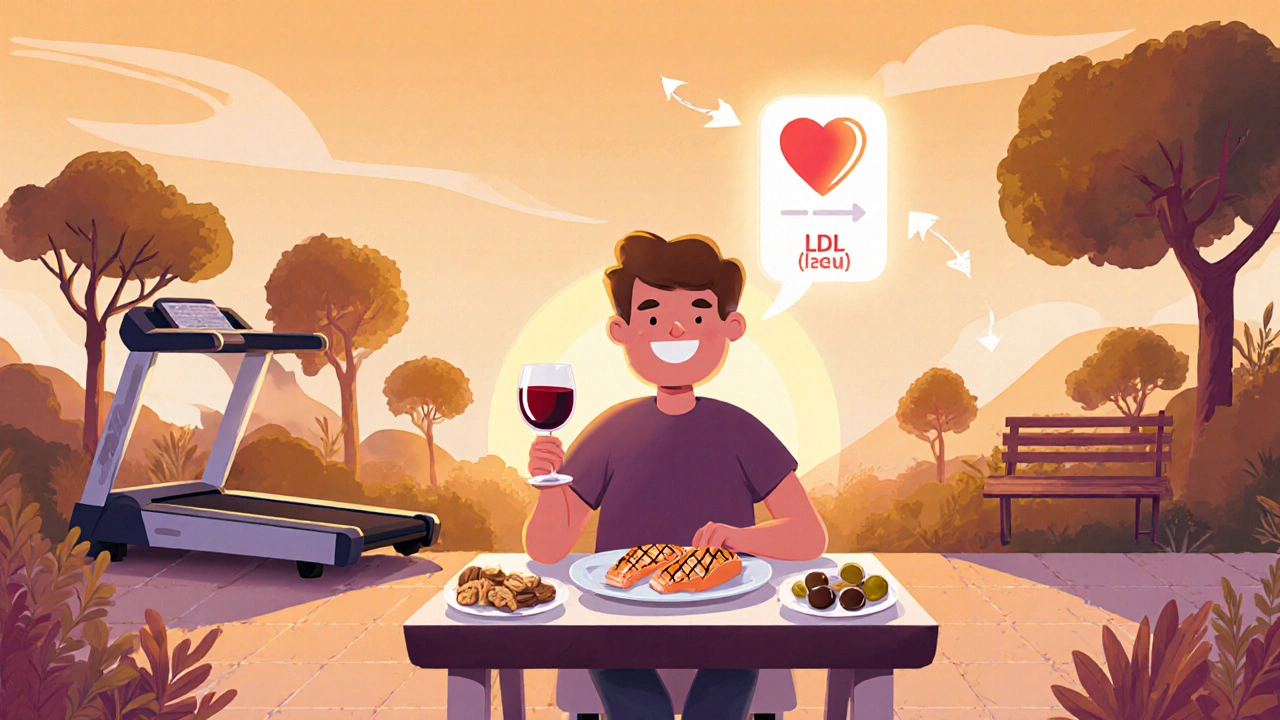
Comparison of Lipid Changes by Drinking Level
| Metric | Abstinent | Moderate (1‑2 drinks/day) | Heavy/Binge (>3 drinks/day) |
|---|---|---|---|
| HDL (+ mg/dL) | Baseline | +5 to +8 | +2 or unchanged |
| LDL (‑ mg/dL) | Baseline | ‑2 to ‑5 | +10 to +20 |
| Triglycerides (+ mg/dL) | Baseline | ±0 | +30 to +80 |
| Total Cholesterol (+ mg/dL) | Baseline | ±0 | +15 to +25 |
Numbers are averages from pooled cohort data; individual responses will vary.
Common Myths Debunked
- Myth: "A glass of red wine cures high cholesterol."
Reality: The modest HDL boost is real, but it does not offset a diet high in saturated fat. - Myth: "Only spirits raise triglycerides."
Reality: Any high‑calorie alcohol, even wine, can raise triglycerides when consumed in excess. - Myth: "If I take statins, I can drink freely."
Reality: Statins reduce LDL, but heavy alcohol still spikes triglycerides and can damage the liver, reducing medication efficacy.
Bottom Line: Balance Beats Extremes
For most people with hypercholesterolemia, enjoying a modest amount of alcohol-especially red wine with a meal-won’t sabotage cholesterol control and may even give a slight HDL lift. The real danger lies in regular bingeing or heavy daily drinking, which flips the lipid picture and adds extra strain on the liver.
Combine any drinking habit with a cholesterol‑friendly diet, regular exercise, and routine blood‑test monitoring. When in doubt, talk to your GP or a qualified dietitian who can tailor advice to your genetics, age, and existing meds.
Does moderate wine really raise HDL?
Yes. Studies consistently show a 5‑8 mg/dL increase in HDL with 1‑2 glasses of red wine per day, likely due to polyphenols and ethanol’s effect on liver enzymes.
Can I drink beer if I’m on statins?
Occasional light beer (≤1 drink) is generally safe, but heavy intake can raise triglycerides and interfere with liver metabolism, potentially reducing statin effectiveness. Always check with your doctor.
Is there a safe amount of alcohol for people with familial hypercholesterolemia?
Because genetic LDL levels are already high, most specialists advise limiting alcohol to ≤1 drink per week, focusing on diet and medication instead.
How long does it take for triglycerides to drop after a binge?
Triglyceride spikes usually peak within 12‑24 hours and return to baseline after 2‑3 days if you resume normal eating and avoid further alcohol.
Should I quit alcohol completely if my LDL is high?
Complete abstinence is the safest route for severe LDL elevation, especially when combined with other risk factors. However, many achieve target LDL with medication and only moderate drinking, as long as they avoid binge patterns.
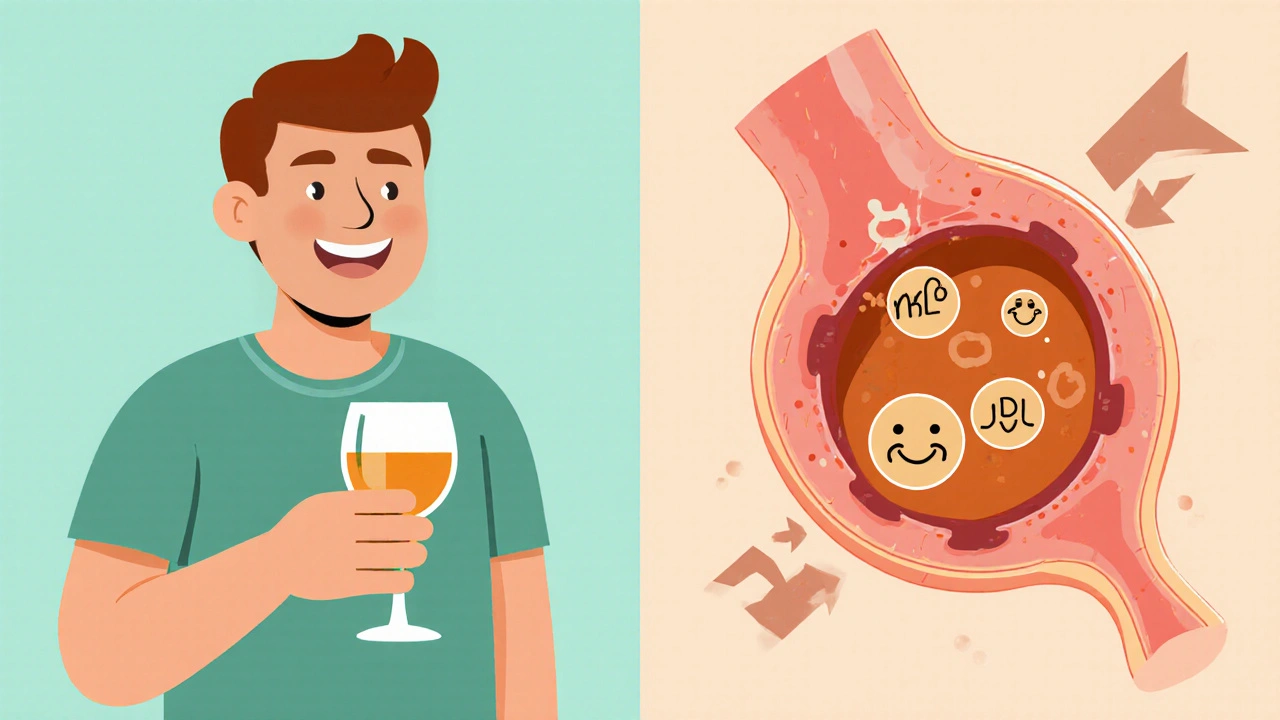
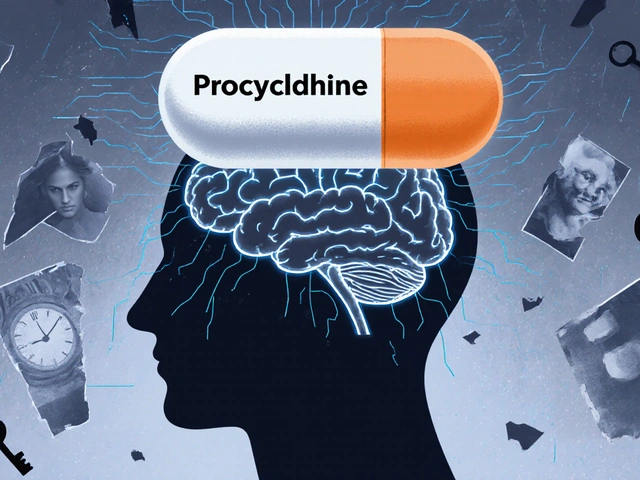


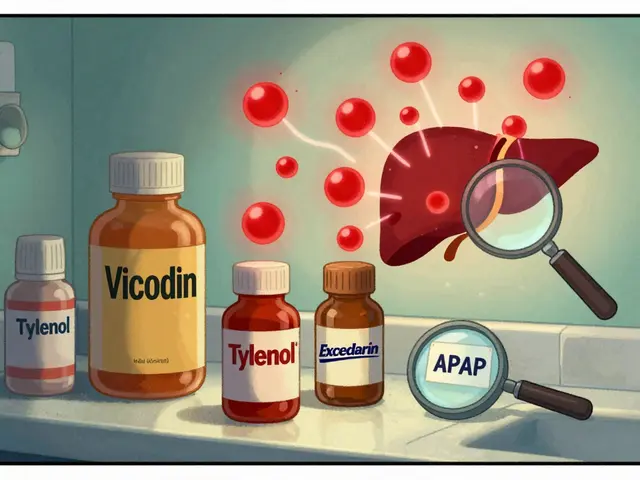
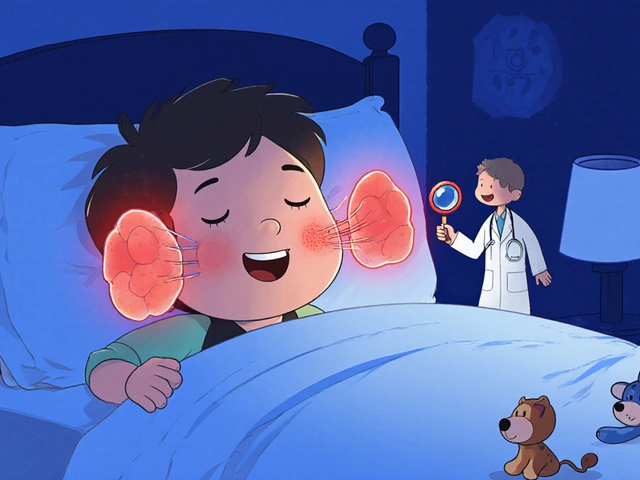
Andrew Hernandez
21 October, 2025 . 00:40 AM
A moderate glass of wine can fit into a cholesterol‑friendly lifestyle.
Demetri Huyler
21 October, 2025 . 01:40 AM
Look, the data is clear: a single daily pour of vino nudges HDL upwards, but the effect is marginal at best. The myth of wine as a miracle cure is a romantic delusion that serves only the wine industry’s agenda. Yet, if you sip responsibly, you won’t sabotage your lipid profile – just don’t let it become an excuse for overindulgence.
Wesley Humble
21 October, 2025 . 03:26 AM
From a biochemical standpoint, ethanol oxidation yields acetate, which transiently fuels hepatic de novo lipogenesis, thereby elevating VLDL‑derived triglycerides. 📊 Moreover, the HDL elevation observed with moderate intake is principally mediated by increased activity of cholesteryl‑ester transfer protein (CETP), a mechanism that plateaus beyond one drink per day. Clinically, the net cardiovascular benefit is contingent upon the balance between HDL augmentation and triglyceride surge, a nuance often omitted in popular discourse. 🧪 Consequently, I advise patients to monitor fasting triglycerides after any episode of binge drinking, as the rise can persist for 48‑72 hours. Finally, the interaction with statins is not merely pharmacokinetic; hepatic enzyme induction may attenuate statin efficacy, warranting dose reassessment.
barnabas jacob
21 October, 2025 . 04:26 AM
Yo, the whole "just drink wine and boost your HDL" line is pure pseudoscience – it ignores the underlying metabolic jargon like hepatic steatosis and VLDL overproduction. Heavy boozin’ will crank up LDL particles and triglycerides faster than a turbo‑charged engine, no doubt. And don’t even get me started on the genetic predisposition stuff; fam‑hypercholesterolemia folks get wrecked by even modest booze. Bottom line: the sauce ain’t worth the risk.
Rajesh Myadam
21 October, 2025 . 05:26 AM
I completely understand the concerns raised regarding the metabolic impact of alcohol, especially for those with a family history of high cholesterol. It’s essential to remember that individual responses can differ, and a personalized approach-perhaps limiting intake to a single glass on special occasions-might be the safest route. Monitoring lipid panels regularly will give clear feedback on how your body reacts.
Alex Pegg
21 October, 2025 . 07:36 AM
While many tout moderation, the most prudent strategy for anyone with elevated LDL is outright abstinence. Even a modest amount of alcohol can trigger hepatic enzyme changes that blunt the effectiveness of statins, and that’s a risk I’m not willing to take. The cultural glorification of wine is simply a marketing ploy.
laura wood
21 October, 2025 . 08:36 AM
I respect the viewpoint on abstinence, but many patients find that a single glass of red wine with dinner actually helps them adhere to a healthier diet overall. If one chooses to drink, emphasizing low‑risk patterns-such as no more than one drink, paired with nutrient‑dense foods-can mitigate many of the concerns raised.
Sebastian Green
21 October, 2025 . 10:23 AM
From a personal standpoint, I’ve seen patients who struggle with total restriction become discouraged and abandon their broader health plan. Introducing a modest, controlled amount of alcohol, when done responsibly, can sometimes serve as a morale booster, provided it’s paired with regular exercise and a heart‑healthy diet.
jessie cole
21 October, 2025 . 11:46 AM
Let us consider the broader picture, dear friends. First, the primary aim for anyone with hypercholesterolemia is to lower LDL to target levels, a goal achievable through diet, medication, and lifestyle changes. Second, moderate alcohol consumption can be incorporated without derailing this objective, but only if it follows strict guidelines.
Begin by establishing a baseline lipid panel; know exactly where your numbers stand before any alteration. Third, if you choose to enjoy a drink, limit it to one standard serving per day for women and up to two for men, and never exceed this amount.
Fourth, select beverages wisely-red wine may confer a modest HDL benefit, yet the ethanol content, not the polyphenols, drives the effect. Fifth, always pair alcohol with a balanced meal rich in omega‑3 fatty acids, soluble fiber, and plant sterols; this combination blunts triglyceride spikes.
Sixth, stay vigilant for binge episodes, as a single night of heavy drinking can raise triglycerides for up to three days, undermining your progress. Seventh, if you are on statins, schedule regular liver function tests; heavy drinking can elevate hepatic enzymes and compromise drug metabolism.
Eighth, maintain consistent physical activity-at least 150 minutes of moderate aerobic exercise per week-to enhance HDL and improve overall cardiovascular health.
Ninth, re‑evaluate your lipid profile after three months of any new drinking pattern; adjust accordingly based on objective data.
Tenth, remember that individual genetics matter: those with familial hypercholesterolemia may need stricter limits or complete abstinence.
Finally, approach alcohol with mindfulness and patience, treating it as a small component of a comprehensive health strategy, not a primary solution. By following these steps, you can enjoy occasional drinks while safeguarding your heart.